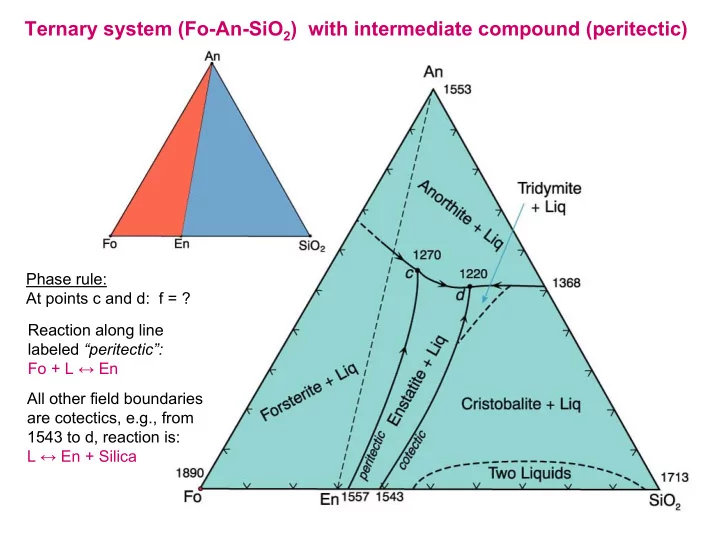

Ternary system (Fo-An-SiO 2 ) with intermediate compound (peritectic) Phase rule: At points c and d: f = ? Reaction along line labeled “peritectic”: Fo + L ↔ En All other field boundaries are cotectics, e.g., from 1543 to d, reaction is: L ↔ En + Silica
Ternary system (Fo-An-SiO 2 ) with intermediate compound (peritectic) Note: Fields of crystallization Eq m Xtl n of comp n a: of An, Fo, En and silica Eq m Xtl n of comp n d: a-b: Fo d-e: Fo b-c: Fo + L ↔ En e-f: Fo + L ↔ En c: Fo + L ↔ En + An f-g: En g-d': En + An at d': En + An + Silica: (at d': L ↔ En + An + Silica) g d' f Recall: tangent rule and how to determine nature of reactions along univariant boundaries d e and at invariant points
Ternary system (Fo-An-SiO 2 ) with intermediate compound (peritectic) Fractional crystallization of composition a: a - b: Forsterite b - e: Enstatite e - d: En + An For melting of a solid assemblage of bulk composition a , what would be the first liquid produced? What differences are there between equilibrium melting and fractional melting of composition a ?
Important systems with more than 3 components 1. “Granite” system (Ab-Or-Qz-H 2 O) This 4 component (Quaternary) system has been studied extensively since the publication of the classic memoir in 1958 by Tuttle and Bowen (GSA Memoir 74). There are 4 ternary sub-systems (Ab-Or-Qz; Ab-Or-H 2 O; Ab-Qz-H 2 O; Or-Qz-H 2 O) and 6 binary sub-systems. We have discussed the phase equilibria in the Ab-Or-H 2 O system. Time does not permit an extensive discussion of all the ternary systems so we will just focus on some of the key results at P = 5 kbars Qz H 2 O H 2 O V M: minimum on V a: L(Ab,Qz,V) b: L(Or,Qz,V) liquidus Qz+L 1065 1130 L+V L + V m(~1000) 1100 Afs+L a (690) 756 1100 875 b (730) Qz+L Ab+L Qz+L Or+L Ab Or Ab 1130 Qz Or Qz 1065 H 2 O To represent the phase equilibria in the quaternary (“granite”) system, the phase relations obtained under water-saturated conditions are a Qz projected from the water apex on to the triangular base of the tetrahedron, e.g., point a within the tetrahedron projects to a' on the base a' Ab Or
“Granite” System at 5 kb Heavy lines show the location H 2 O of liquid compositions in Schematic perspective projection of V equlilibrium with various the H 2 0-saturated liquidus surface in crystalline assemblages the Ab-Or-Qz-H 2 O system at 5 kb Light lines (below the V-sat d This surface is labeled a-b-c-d-e-f-g surface are water present but V- and the numbers correspond to the undersat d equilibria, e.g., 690ºC- temperatures in ºC at each point 1130ºC line represents L(Ab,Qz) b(730ºC) – g(645ºC): L(Or ss ,Ab ss ,V) Fluid compositions lie f(690ºC) – g(645ºC): L(Ab ss ,Qz,V) L+V L+V close to H 2 O apex f(730 ºC ) – g(645ºC): L(Or ss ,Qz,V) e g(645ºC): L(Ab ss ,Or ss ,Qz,V) Qz At 5 kb, H 2 O-sat d liquids 730 690 d 645 contain ~10 wt% H 2 O f g L(Or ss ,Ab ss ,Qz,V) c a 1065 1130 701 b Ab Or
“Granite” [Ab-Or-Qz-H 2 O] System at 2 kb and 10 kb (water saturated) Note: There is no ternary eutectic at P H2O = At P H2O = 10 kb, there is a ternary eutectic at 2kb. Instead, there is a minimum at 680ºC in T = 635ºC and the fields of Ab ss , Or ss and the field boundary separating the fields of quartz are distinct. Basically, the solvus and quartz and alkali feldspar. Recall the Ab-Or the solidus have intersected. system which shows that the solidus has not Phase Rule: variance at the eutectic? intersected the solvus at low P. Crystallization and melting behavior?
Solidus in “Granite” [Ab-Or-Qz-H 2 O] System to 20kb (water saturated) Note: Curve shows the water saturated solidus in the “granite” system as a function of P. The diagonal line shows the one feldspar—two feldspar boundary (in effect the P and T of the crest of the solvus) The inset diagram shows the composition of the minima (at 1 and 2 kb) and the eutectic (at 5, 10 and 20 kb). At pressures above ~16 kb, albite is unstable and breaks down to jadeite + quartz. This produces an invariant point. What phases at present at the invariant point? The shaded area show the composition of most natural granites plotted on this diagram.
Recommend
More recommend